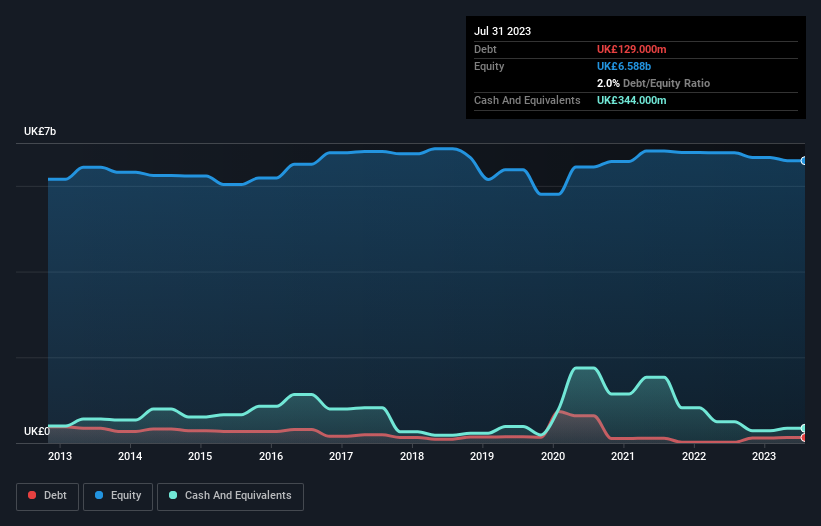Stock Analysis
- United Kingdom
- /
- Specialty Stores
- /
- LSE:KGF
Is Kingfisher (LON:KGF) Using Too Much Debt?

Warren Buffett famously said, 'Volatility is far from synonymous with risk.' So it seems the smart money knows that debt - which is usually involved in bankruptcies - is a very important factor, when you assess how risky a company is. As with many other companies Kingfisher plc (LON:KGF) makes use of debt. But the more important question is: how much risk is that debt creating?
When Is Debt Dangerous?
Debt assists a business until the business has trouble paying it off, either with new capital or with free cash flow. Ultimately, if the company can't fulfill its legal obligations to repay debt, shareholders could walk away with nothing. However, a more common (but still painful) scenario is that it has to raise new equity capital at a low price, thus permanently diluting shareholders. Of course, plenty of companies use debt to fund growth, without any negative consequences. The first step when considering a company's debt levels is to consider its cash and debt together.
See our latest analysis for Kingfisher
What Is Kingfisher's Debt?
As you can see below, at the end of July 2023, Kingfisher had UK£129.0m of debt, up from UK£18.0m a year ago. Click the image for more detail. However, its balance sheet shows it holds UK£344.0m in cash, so it actually has UK£215.0m net cash.

A Look At Kingfisher's Liabilities
According to the last reported balance sheet, Kingfisher had liabilities of UK£3.11b due within 12 months, and liabilities of UK£2.49b due beyond 12 months. Offsetting this, it had UK£344.0m in cash and UK£437.0m in receivables that were due within 12 months. So its liabilities outweigh the sum of its cash and (near-term) receivables by UK£4.82b.
Given this deficit is actually higher than the company's market capitalization of UK£4.12b, we think shareholders really should watch Kingfisher's debt levels, like a parent watching their child ride a bike for the first time. Hypothetically, extremely heavy dilution would be required if the company were forced to pay down its liabilities by raising capital at the current share price. Given that Kingfisher has more cash than debt, we're pretty confident it can handle its debt, despite the fact that it has a lot of liabilities in total.
But the bad news is that Kingfisher has seen its EBIT plunge 15% in the last twelve months. We think hat kind of performance, if repeated frequently, could well lead to difficulties for the stock. There's no doubt that we learn most about debt from the balance sheet. But ultimately the future profitability of the business will decide if Kingfisher can strengthen its balance sheet over time. So if you want to see what the professionals think, you might find this free report on analyst profit forecasts to be interesting.
Finally, a business needs free cash flow to pay off debt; accounting profits just don't cut it. Kingfisher may have net cash on the balance sheet, but it is still interesting to look at how well the business converts its earnings before interest and tax (EBIT) to free cash flow, because that will influence both its need for, and its capacity to manage debt. Over the most recent three years, Kingfisher recorded free cash flow worth 66% of its EBIT, which is around normal, given free cash flow excludes interest and tax. This cold hard cash means it can reduce its debt when it wants to.
Summing Up
While Kingfisher does have more liabilities than liquid assets, it also has net cash of UK£215.0m. So while Kingfisher does not have a great balance sheet, it's certainly not too bad. The balance sheet is clearly the area to focus on when you are analysing debt. However, not all investment risk resides within the balance sheet - far from it. For example - Kingfisher has 3 warning signs we think you should be aware of.
At the end of the day, it's often better to focus on companies that are free from net debt. You can access our special list of such companies (all with a track record of profit growth). It's free.
Valuation is complex, but we're helping make it simple.
Find out whether Kingfisher is potentially over or undervalued by checking out our comprehensive analysis, which includes fair value estimates, risks and warnings, dividends, insider transactions and financial health.
View the Free AnalysisHave feedback on this article? Concerned about the content? Get in touch with us directly. Alternatively, email editorial-team (at) simplywallst.com.
This article by Simply Wall St is general in nature. We provide commentary based on historical data and analyst forecasts only using an unbiased methodology and our articles are not intended to be financial advice. It does not constitute a recommendation to buy or sell any stock, and does not take account of your objectives, or your financial situation. We aim to bring you long-term focused analysis driven by fundamental data. Note that our analysis may not factor in the latest price-sensitive company announcements or qualitative material. Simply Wall St has no position in any stocks mentioned.
About LSE:KGF
Kingfisher
Kingfisher plc, together with its subsidiaries, supplies home improvement products and services primarily in the United Kingdom, Ireland, France, and internationally.
Flawless balance sheet, undervalued and pays a dividend.

